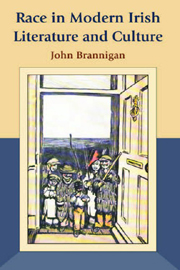Book contents
- Frontmatter
- Contents
- Illustrations
- Acknowledgements
- Introduction
- 1 1922, Ulysses, and the Irish Race Congress
- 2 Face Value: Racial Typology and Irish Modernism
- 3 ‘Aliens in Ireland’: Nation-building and the Ethics of Hospitality
- 4 ‘Ireland, and Black!’: The Cultural Politics of Racial Figuration
- Conclusion: Imagining the ‘New Hibernia’
- Bibliography
- Index
Conclusion: Imagining the ‘New Hibernia’
Published online by Cambridge University Press: 12 September 2012
- Frontmatter
- Contents
- Illustrations
- Acknowledgements
- Introduction
- 1 1922, Ulysses, and the Irish Race Congress
- 2 Face Value: Racial Typology and Irish Modernism
- 3 ‘Aliens in Ireland’: Nation-building and the Ethics of Hospitality
- 4 ‘Ireland, and Black!’: The Cultural Politics of Racial Figuration
- Conclusion: Imagining the ‘New Hibernia’
- Bibliography
- Index
Summary
On the morning of 7 June 2004, just a few days before the citizenship referendum, two men wearing balaclavas hung a life-sized black doll from a railway bridge in Longford town. A bag was placed over the doll's head, and a sign hung around its neck which read ‘Niggers go home – you'll never be Irish’. As the journalist who reported the incident for the Sunday Independent observed, the mock execution, the effigy, and the balaclavas may all have been modelled upon ‘the darkest days of the Klu Klux Klan [sic]’, but the performance was unmistakably charged with the racist undertones of the referendum itself. Government ministers oscillated between depicting the proposed amendment as a purely pragmatic issue of closing loopholes in Irish citizenship law which were out of step with European standards, and trotting out unsubstantiated ‘scare’ stories about the apparent ‘flood’ of expectant mothers arriving from Africa solely in order to give birth and collect the passport. Whichever reason for approving the amendment was proffered, however, the referendum debate, such as it was, posed the same symbolic antithesis to Irish voters as had preoccupied the voters and volunteers at the foundation of the state: on the one hand, there were white Europeans deserving of prosperity, independence, and human rights, while on the other, there were black Africans seemingly undeserving of any of these things. As John Harrington argues in tracing the trajectory of discourses of ‘citizenship’ in post-independence Ireland, the Europeanism which had for so long represented for Irish liberals the aspiration towards cosmopolitan modernity was also a racialised identity forged in opposition to an idea of black Africa as ‘a state of nature incapable of development’.
- Type
- Chapter
- Information
- Race in Modern Irish Literature and Culture , pp. 222 - 228Publisher: Edinburgh University PressPrint publication year: 2009

